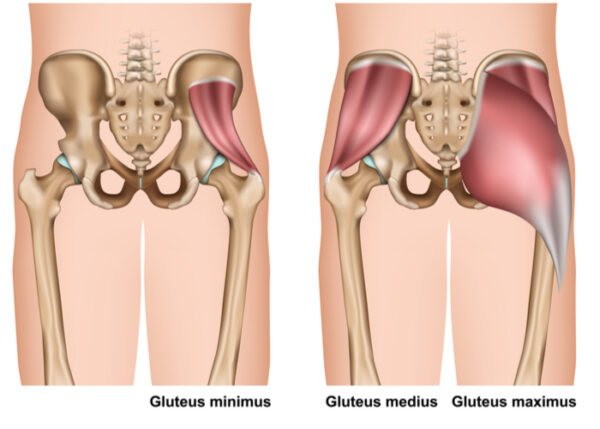Gluteus Medius & Minimus Tear Specialist

Are you experiencing an abnormal gait, hip pain, and lower back pain? Do symptoms become worse with long periods of sitting, standing, and walking? If so, you may have a gluteus medius or gluteus minimus tear. Gluteus tear specialist, Dr. Jervis Yau provides diagnosis and both surgical and nonsurgical treatment options for patients in Santa Barbara who have suffered a gluteus tear. Contact Dr. Yau’s team today!
Gluteus Medius & Minimus Tear Overview
The gluteal muscles allow patients to engage in athletic activities such as jumping and running. Located in the outer buttocks, the gluteus medius and gluteus minimus muscles work in unison to stabilize the pelvis, straighten the hip joint and assist with outer hip motions. A torn gluteus minimus or a gluteus medius tear can occur at its attachment site on the femur (thighbone) from aging, repetitive overuse or a traumatic injury. Dr. Jervis Yau, Santa Barbara, Goleta, Santa Maria and Ventura, California area orthopedic hip specialist, specializes in the treatment of gluteal muscle tears so patients can return to an active lifestyle.
There are two strong, broad muscles in the gluteal area, including:
- Gluteus medius- Located at the outer hip portion
- Gluteus minimus- Located immediately beneath the gluteus medius
What are the Symptoms of Gluteus Medius and Gluteus Minimus Tears?
Patients affected by tears in the gluteal muscles often experience pain and weakness in the outer hip and lower back, along with gait abnormalities. These symptoms may intensify with prolonged walking, standing and sitting. Patients may also experience pain over the lateral hip when lying on that side of the body.

How are Gluteus Medius and Gluteus Minimus Tears Diagnosed?
Diagnosis of gluteal tendon tears involve a thorough history and physical examination along with MRI confirmation of the tear. During the examination, Dr. Yau will perform a series of tests to determine lateral hip tenderness, pain level and hip muscle weakness.
- Grade 1- Mild pain with little or no loss of mobility
- Grade 2- Partial tear with mild pain and a noticeable loss in strength and flexibility
- Grade 3- Complete tear with severe pain, complete loss of strength and limited mobility
How are Gluteus Medius and Gluteus Minimus Tears Treated?
Non-Surgical
Many cases of a gluteus medius and gluteus minimus tears can be treated with non-operative measures. Dr. Yau commonly prescribes a combination of rest, ice, medications, activity modifications and physical therapy.
Surgical
If the patient fails conservative treatment or has a complete tear, Dr. Yau commonly recommends surgical repair of the torn tendon in order to restore hip function. Although many of these tears can be repaired through a minimally invasive arthroscopic approach, Dr. Yau will make the determination based on the severity of tear. Some more extensive tendon tears are better repaired through a traditional open repair.
For more information on injuries to the gluteal muscles, or to determine if you have experienced a gluteus medius tear or a torn gluteus minimus, please contact the orthopedic office of Dr. Jervis Yau, hip specialist located in the Santa Barbara, Goleta, Santa Maria and Ventura, California communities.
Gluteus Medius and Gluteus Minimus Tear FAQ
1. Where is the gluteus minimus?
The gluteus muscles are broad, strong muscles that make up the outer hip in the human body. The gluteus minimus is the smallest of the gluteal muscles and is located immediately beneath the gluteus medius. This muscle helps with internal and external rotation of the femur at the hip joint.
2. Where is the gluteus medius?
The gluteus medius is located on the outer part of the hip. It attaches to the leg at the top of the thigh bone, close to the hip joint at the greater trochanter. The gluteus medius works to provide rotation of the thigh outward from the center of the body, which helps stabilizes the gait.
3. What is a gluteus medius tear?
The gluteus medius attaches at the side of the hip where the bony protrusion called the greater trochanter is located. A gluteus medius tear occurs when the muscle is torn from the greater trochanter. These tears are typically classified as overuse injuries that begin with small tears that accumulate over time from repetitive motions. Gluteus medius tears are classified based on the severity of the tear – Grade 1 being mild and Grade 4 being severe.
Primary symptoms of a gluteus medius tear includes an abnormal gait, hip pain and lower back pain. These symptoms can become worse with long periods of sitting, standing and walking. Patients have also reported tenderness on the affected side when lying down.
Gluteus medius tears are most commonly seen in athletes who put repetitive stress on the joint. Runners who suddenly intensify their routine instead of gradually can cause a gluteus medius tear.
4. What is a gluteus minimus tear?
The gluteus minimus is located in the buttock region and helps with abduction (movement away from the body) and medial (inward) rotation of the thigh. It is located deep and slightly anterior to the gluteus medius. A tear to the gluteus minimus can occur from a traumatic injury. In most cases, a gluteus minimus tear is degenerative and is caused by chronic inflammation from repetitive movements and overuse.
Primary symptoms of a gluteus minimmus tear includes hip pain, an abnormal gait and lower back pain. These symptoms can increase with long periods of sitting, standing and walking. In some cases, patients have also reported tenderness on the affected side when lying down.
5. What is gluteus medius pain?
Gluteus medius pain will occur on the affected side of the hip. When a gluteus medius tear is present, patients report feeling pain in the hip and lower back. Pain can increase with long periods of sitting, standing and walking. Weakness on the injured side of the hip is commonly seen when severe damage is present.
6. What is gluteus minimus pain?
Gluteus minimus pain can occur on the outer part of the hip, or thigh. In some cases, pain can radiate down to the calf and ankle. Some patients have also reported numbness in the buttock, hip and thigh region. Pain can also occur when rising from a seated position, or when lying on the affected side.